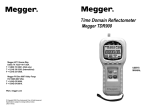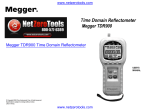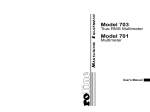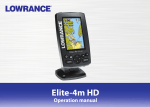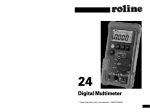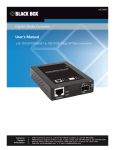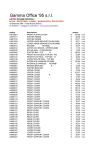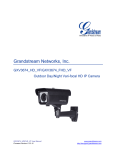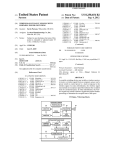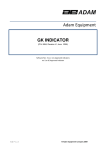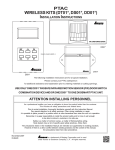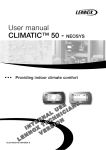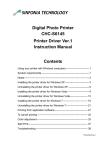Download Manual - Test Equipment Depot
Transcript
Time Domain Reflectometer Megger TDR900 99 Washington Street Melrose, MA 02176 Phone 781-665-1400 Toll Free 1-800-517-8431 Visit us at www.TestEquipmentDepot.com USER’S MANUAL © Copyright 2003 Fine Instruments Corp. All right reserved. Specifications subject to change without notice. Litho in Korea. Basic Specifications Maximum Range Range Selection Resolution : Depends upon the V.O.P of the cables under test. 12,000 ft (3.7 km)@ V.O.P 99.9 % 9,800 ft (3.0 km)@ V.O.P 80.0 % 8,000 ft (2.4 km)@ V.O.P 66.0 % 6,200 ft (1.9 km)@ V.O.P 50.0 % : Automatic range control : 20 inches (50 cm) Accuracy WARNING! SOURCES LIKE SMALL HAND-HELD RADIO TR ANSCEIVERS, FIXED STA TION RA DIO AND TELEVISION TRANSMITTERS, VEHICLE RA DIO TR ANSM IT TERS AND CEL LUL AR PHONES GENERATE ELECT ROMAGNET IC RADIATION THAT MAY INDUCE VOLTAGES IN THE TEST LEADS OF THE MULTIMETER. IN SU CH CASES THE ACCURA CY OF T HE MULT IMETER C ANNOT BE GUARAN TEED DUE TO PHYSICAL REASONS. : ± 2 % of reading + 20 inches (50 cm) < 300 ft (100 m) ± 2 % of reading > 300 ft (100 m) This accuracy is effective for Coaxial Cables up to 8,000 ft, Telephony Cables up to 6,000 ft, and Structured Wiring up to 3,000 ft. Output Impedance : 25, 50, 75, 100, 125 or 150 ohms Impedance Selection : Automatic output impedance control Velocity Factor : Adjustable from 1.0 % to 99.9 % Tone Generator Cable Library Memory Location Connector : : : : Oscillating 810 - 1100 Hz (5 Vp-p unloaded) 39 standard cable types 20 for custom cable types BNC Input Protection : 250 V RMS Line Voltage Detection : 6.5 V Warning The product should not be connected to any energized circuits. Connection to mains supply voltages will damage the Meter and could be hazardous to the user. The product contains parts that can be damaged by static disc harge. Disc harge the c able t o be te st ed be fore connecting the product to the cable. Read “Safety Information” before using this Meter. 1 CONTENTS 1. Safety Information 2. The TDR Cable Length Meter 3. Controls, Indicators, and Buttons Overview 4. Meter Operation 4.1 Principles of operation 4.2 How to connect a cable to the Meter 4.3 How to set the cable type 4.3.1 Selecting a library cable type 4.3.2 Cable library for 39 standard cable types 4.3.3 Testing cables not included in library 4.4 How to determine unknown V.O.P settings 4.4.1 Expanding cable library for custom cable types using nonvolatile memory 4.5 How to measure cable length 4.6 How to check networks (Thin Ethernet) 5. Changing the measurement scale between English and Metric 6. Measurement accuracy 7. Theoretical and actual V.O.P 8. Special features 8.1 Low battery indication 8.2 Overrange indication 8.3 Enable or disable the auto-power-off mode 8.4 Tone Generator mode 8.5 Line Voltage Detection mode 9. Maintenance 10. Specifications Repair and Warranty 2 1. Safety Information 3 4 5 8 8 8 9 9 10 12 14 15 19 19 20 21 22 23 23 23 24 25 25 26 27 Safety Warnings This Meter c omplies with the safety requirements of IEC 1010-1 : 2001. It is designed for use on de-energized circuits only, however this Meter is protected against telephone networking voltages (EN 60950 : 1999 Sec. 2.3). Connection to any mains supply voltages may result in damage to the Meter and/or a hazard to the user. Hence the user must assume responsibility for ensuring his or her own safety. International Symbols used on the Meter Caution! Refer to the explanation in this manual. Double insulation or Reinforced insulation Battery Meter complies with current EU Directives. International Standards Safety EMC : IEC 1010-1 : 2001 : EN 61326 : 1997 + A1 : 1998 ESD EM Burst Surge Conducted RF EMC Standard IEC 1000-4-2 IEC 1000-4-3 IEC 1000-4-4 IEC 1000-4-5 IEC 1000-4-6 Category of Pass A A A A A 3 2. The TDR Cable Length Meter The Meter is a handheld and battery operated instrument capable of measuring cable lengths and finding distance to an open or a short using TDR(Time Domain Reflectometry) techniques, given access to one end only. The Meter can be used for any cable consisting of at least two insulated metallic elements, one of which may be the sheath or shield of the cable. The Meter has automatic internal matching networks to allow testing of 25 , 50 , 75 , 100 , 125 , or 150 cables, which correspond to power, telephony, CATV, and LAN, etc. cables. 3. Controls, Indicators, and Buttons Overview Although this manual describes the operation of the Meter for both Metric measurement and English measurement, all illustrations and examples assume use of the Meter for English measurement. (2) The Meter can be closely matched to the cable under test using the menu selection keys. The V.O.P(Velocity of Propagation) value can be similarly adjusted to match the cable under test; thus ensuring an accurate distance measurement. (1) The Meter incorporates an oscillating tone generator, that is detectable with a standard tone probe (not supplied) available in the marketplaces, for use in the tracing and identification of pairs within a cable . (3) The Meter displays “ ” message and stops operation if line voltage of the cable under test exceeds 6.5 V when the Meter is turned on. The BNC terminal is protected up to 250 V RMS in order to prevent it from being demaged by its misconnection to live circuits of networking. You can s tore up to 20 cable test results for custom cable types in internal nonvolatile memory and the stored cable library provides quick and easy access to 39 standard c able types, which enables ac curate measurement without the necessity of entering V.O.P (Velocity of Propagation). (4) (5) (6) (7) The on-site measurement scale changing feature enables the Meter to be globally used for both Metric measurement and English measurement without changing the measurement scale at factory. The Meter comes with an Alligator Clip adaptor, a user’s manual and a soft carrying case. 4 5 (1) DISPLAY (3) MENU (on screen) SELECTION BUTTONS Extra-large backlit (ICON type 7 segment) LCD. When the Meter is turned on, all display segments and symbols appear briefly (during 1.5 seconds) for a selftest and then the Meter defaults the following initial display. Initial Display When shipped out of factory The Meter defaults V.O.P of 66.0 % and English scale. Each setting of the Meter to a measurement function may activate one or more menu selection button settings on the LCD. Press the corresponding menu selection button to select the desired measurement. Setup Mode Use the menu selection buttons in order to edit desired setup values as follows : Button Function Press to step to next digit in setting value. Press to move t o next Press to Press to Setup. Press to save all settings increase decrease setting value. setting value. and e xit Set up Mo de when setting is ended. (4) POWER ON/OFF BUTTON Press the POWER button for more than 1 second to turn the Meter on. Fig. 1 When turned on after having been used in the field The Meter defaults the V.O.P (e.g. 68.0 %) having been used just before it was turned off. Auto-Power-Off This Meter is completely turned off after 30 minutes of no activities. Press the POWER button to turn the Meter on again. This feature can be disabled (refer to Section 8.). (5) BACKLIGHT ON/OFF BUTTON or EXIT BUTTON Press this button for more than 1 second to turn the backlight on and press this button again for more than 1 second to turn it off. Press this button momentarily to always return to the initial display when the meter is in either SELECT mode or Memory mode. And also press the button momentarily to exit the Tone Generator mode. Fig. 2 (6) MEMORY BUTTON or TONE BUTTON (2) BNC A shielded connector for either coaxial cable or Alligator Clip adaptor (a standard accessory). Press this button momentarily to activate the memory mode. The display shows three menu selections : STORE, RECALL and CLEAR. Press this button for more than 1 second to activate the Tone Generator mode. (Press the EXIT button to exit the Tone Generator mode.) (7) TEST BUTTON 6 Press this button momentarily to measure length, distance to an open or a short, or V.O.P of cable under test. 7 Unshielded multi-core cable : Connect the two clips to any two wires. 4. Meter Operation 4.1 Principles of operation The Meter works by measuring the time taken for a signal to travel to the far end of the cable (or to an intermediate fault) and to return. The velocity at which the signal is transmitted (Velocity of Propagation, that is, V.O.P) will depend upon the characteristics of the cable to be tested. The length is computed from the following formula : travel time X (9.84 X 108) X V.O.P (English measurement) travel time X (3 X 10 8) X V.O.P (Metric measurement) The V.O.P is specified for standard cable types in this manual. However, do not rely solely on the specified V.O.P because variations of up to 20 % can occur between batches of cable. Therefore, if accuracy is critical to your situation, y ou must determine the ac tual V.O.P of each cable. Verify the length measurement by measuring a sample cable (longer than 30 ft, or 10 m) of the same cable type you will be testing. 4.2 How to connect a cable to the Meter Ensure that no power supply or equipment is connected to the cable to be tested. Ensure that the far end of the cable to be tested is either open or shorted (not fitted with a terminator). Connect the Meter to one end of the cable to be tested. 4.3 How to set the cable type The Meter needs to be set for the cable type to be tested before being used to take measurements. If the cable type is listed in the library, setting up is simply a matter of selecting the appropriate cable type from the library. 4.3.1 Selecting a library cable type The library cable type you will select determines the information about V.O.P and the abbreviated trade name of the cable to be tested. 1. Turn the Meter on. 2. The Meter will display the previously selected cable setting (see Fig. 1 and Fig. 2) with its V.O.P. 3. Press the SELECT button then the Meter will display both the LIBRARY symbol (blinking) and the V.O.P symbol. “ blinking ” The cable connection to the Meter is via a BNC connector located at the top of the Meter. For unterminated cables use the Alligator Clip adaptor as follows. Coaxial cable : Connect the red clip to the center wire and the black clip to the shield. Shielded cable : Connect the red clip to a wire adjacent to the shield of the cable and the black clip to the shield. Unshielded twisted pair cable 8 Fig. 3 4. Press the OK button to set the Meter to the LIBRARY mode. The Meter will display the information of the LIBRARY No. 1, when the “ ” will be blinking. : Separate one pair out and connect the two clips to the two wires of a pair. 9 4.3.2 Cable library for 39 standard cable types “ blinking ” Fig. 4 5. Scroll through the library using the , and buttons to find the required cable type. The types are displayed in the Library Number order. The 39 standard cable types are listed in Section 4.3.2 and Section 4.3.3 will explain you how to make the library of 20 customer cable types using the memory mode. 6. Press the OK button to set the Meter to the required cable type. The center line segments of 6 digits in the lower display will be blinking until the TEST button will be depressed. 7. Connect the cable to be tested to BNC connector of the Meter. 8. Press the TEST button to take the required measurements. The displayed V.O.P will be remained on the LCD even after the TEST button was depressed in order to inform the user of the V.O.P of the cable to be tested. When the Meter will be continuously set to the just same cable type as the preceding cable type, the Meter will show the preceding display until the TEST button will be newly depressed. When the Meter is turned off it automatically stores the last setting and will display this setting when powered up. 10 11 4.3.3 Testing cables not included in library 6. Press the OK button again then the default V.O.P value of 66.0 % will start to blink. If the cable type to be tested is not in the library, it can still be tested if the V.O.P is known. If the V.O.P is unknown, refer to Section 4.4. “ blinking ” 1. Turn the Meter on. 2. The Meter will display the previously selected cable setting [see Initial Display of Section 3.(1)] with its V.O.P. 3. Press the SELECT button then the Meter will display both the LIBRARY symbol (blinking) and the V.O.P symbol (see Fig. 3). 4. Press the button then the LIBRARY symbol will stop blinking and the V.O.P symbol will be blinking. 5. Press the OK button to set the Meter to the V.O.P adjusting mode, when the LIBRARY symbol will disappear, the V.O.P symbol will stop blinking, and the “ segments will start to blink. ” “ blinking ” Fig. 6 7. Scroll through the V.O.P value between 1.0 % and 99.9 % by using the and buttons to find the required V.O.P value. , 8. Press the OK button to set the Meter to the required V.O .P value. 9. Connect the cable to be tested to BNC connector of the Meter. 10. Press the TEST button to take the required measurements. For example, the Meter can have the following display. Fig. 5 The Meter can enter into the Calibrate Cable function to determine the V.O.P for a known length of cable by pressing any button out of and buttons when the Meter is in the V.O.P adjusting mode. Then, the will appear replacing the and “ 30.00 ” will be blinking to alert the user that a sample cable longer than 30 ft (10 m) is necessary. 12 Fig. 7 13 4.4 How to determine unknown V.O.P settings 5. Press the OK button. The Calibrate Cable function allows you to determine the V.O.P for a known length of cable and save it for additional measurements of unknown lengths of the same type of cable. V.O.P settings are stored in nonvolatile memory. 6. Press the TEST button to read the V.O.P of the sample cable, when the center line segment of 6 digits will blink waiting for the next measurement. For example, NOTE Lengths measurements are only as accurate as the V.O.P setting for the cable to be measured. V.O.P values can vary substantially between cable manufacturers as well as between cable lots. “ blinking ” Measure and record the V.O.P of a sample length of cable for each cable manufacturer, then mark the V.O.P on each cable drum before installation. Fig. 9 7. Connect the cable to be tested to the Meter. To calibrate a cable manually, perform the following steps : 1. Take a sample of the c able at least 30 ft (10 m) in length to obtain the specified accuracy (longer lengths improve accuracy). 2. Measure its length by direct measurement. 3. Repeat the step 1 to step 5 of Section 4.3.3 then press the button or the button in order to set the Meter to the Calibrate Cable function, when the will appear replacing the and “30.00” will be blinking to let you remind that the length of a sample cable should be at least 30 ft (10 m). “ blinking ” 8. Press the TEST button to take the required measurement. 4.4.1 Expanding cable library for custom cable types using nonvolatile memory The nonvolatile memory of this Meter allows you to store V.O.P values measured in Section 4.4 to expand the cable library up to 20 custom cable types. Use the memory mode to store and recall the measured V.O.P values. Press the MEMORY button momentarily in order to activate the memory mode. The display shows three menu selections :STORE, RECALL and CLEAR. For example, if the below display was obtained in Section 4.4, Fig. 8 4. Connect the sample cable to the Meter and set the actual length of the sample cable using the , and buttons. 14 Fig. 10 15 STORE : This Meter has 20 internal memory locations from 01 to 20. Press the STORE button to store the next available memory location when the memory locations has been partially occupied. Then, the MEM symbol will appear and the currently available location number will be blinking. For example, if the location 04 was occupied, the display shows as the Fig. 11. “ blinking ” If you want to cancel storing the V.O.P setting, press the EXIT button to have the Meter exit memory mode. RECALL : Select RECALL to review the stored value pressing the RECALL button after having the Meter enter into the memory mode. The upper display will show the V.O.P value of the memory location 01 and the 01 (blinking). Select the required memory location number using the , and buttons. Press the EXIT button to exit the memory mode. For example, if the memory location 05 would be selected, the Meter will display as follows : Fig. 11 When all the memory locations are not occupied, the V.O.P segments will display “ ”. A particular memory location can be selected using the , and Fig. 13 buttons. Press the OK button to prepare storing the V.O.P value measured in Section 4.4 in the location 05. Then, the display shows as the Fig. 12. If you want to cancel this RECALL function, press the EXIT button again to exit the memory mode. Fig. 12 Press the STORE button then the Meter will display blinking “ ” while the measured V.O.P is being stored. The Meter will display “ ” replacing “ ” after the V.O .P has been stored. 16 17 CLEAR : Select CLEAR to erase the stored value pressing the CLEAR button after having the Meter enter into the memory mode. The upper display will show the V.O.P value of the memory location 01 and the 01 (blinking), Select the required memory location number using the , and buttons. Press the OK ( ) button to exit the memory mode, when the lower display will show “ ” while the Meter is performing CLEAR function. For example, if the V.O .P of the memory location 05 would be required to be erased, the Meter will display as follows : 4.5 How to measure cable length (1) Set the cable type or the V.O.P for the cable to be measured. (2) Connect the Meter to the cable as described in Section 4.2. (3) Press the TEST button. If there are no shorts in the cable, the length of the cable will be displayed in the lower display with “ ” in the upper right display. If there is a short in the cable, the distance to the short will be displayed in the lower display with “ ” in the upper right display. If the cable is beyond the measurement range, the display will show “ in the lower display. ” 4.6 How to check networks (Thin Ethernet) Fig. 14 Press the CLEAR button to complete the CLEAR function. If you want to cancel this CLEAR function, press the EXIT button again to exit the memory mode. Completing the CLEAR function, the Meter will show the same display as that which the Meter showed just before entering into the CLEAR function While performing the following tests, no equipment should be connected to the network. (1) Set the Meter for a network cable type (e.g. Ethernet 9880). (2) Remove 50 W terminators from both ends of network. (3) Connect the Meter to one end of the network. (4) Press the TEST button. The length of the network will be displayed in the lower display with “ ”. (5) Repeat steps (3) and (4) from the other end of the network. If the MEMORY button is depressed while the Meter is performing the memory mode, the Meter will return to the previous mode where the Meter was set before entering into the memory mode. When the memory location 01, 02, 03 and 05 were occupied and the memory location 04 was unoc cupied, the STORE function stores the data from the memory location 04. If the length shown is just same from either end, this length indicates the total length of the network. If the lengths are differ and are less than the expected, this is probably due to an open circuit in the network at the distance displayed. If the length is displayed in the lower display with “ ”, this indicates that a short circuit exists in the network at the distance shown. (6) Disconnect the Meter and refit the terminators to the network. 18 19 5. Changing the Measurement Scale between English and Metric Choice of the measur ement units : This Meter can display cable lengths in ei ther Engli sh s ys tem (ft, i n) or Metric s ys tem ( m, cm). T o change the measurement sc ale system, press the UNIT button after the previous length measurement is carried out. Then, the Meter will display “ ” in the lower display as the following example for English to Metric measurement conversion. 6. Measurement Accuracy For coaxial, twisted pair and shielded cable types, an accuracy of 2 % (of reading) can be expected, or 20 in (0.5 m) for a cable less than 30 ft (10 m). The V.O.P is less well defind with unshielded multicore cable (including mains cable) and is lower when the cable is tightly wound on a spool than when it is installed. This is due to capacitance and inductance effects between the turns. Therefore, the accuracy for these cables can be a little bit deteriorated. The BNC to Alligator Clip adaptor has an effective length of 8 inches (20 cm). Fig. 15 Press the TEST button to read the cable length in Metric scale. Please note that this feature enables the Meter compatible with both English scale system and Metric scale system very conveniently without returning the Meter to factory. 20 21 7. Theoretical and Actual V.O.P Theoretically V.O.P can be calculated from the dielectric constant, but actual values often differ slightly from the theoretical one. In an actual cable the dielectric may not fill up the space between the conductors completely. This can cause the effect of increasing V.O.P. In twisted pair cables the V.O.P depends upon the pitch of the twist to some extent. The tighter the pitch the more dielectric and the less air space so the V.O.P is higher. For example, variation of V.O.P between pairs with CAT 5 is typically ± 2 % because the different pairs of CAT 5 are deliberately given staggered pitches to reduce crosstalk. 8. Special Features 8.1 Low battery indication The Meter displays “ ” in the upper display to indicate the status of low battery. Replace the batteries immediately. Never leave a weak or dead battery in the Meter. Even leak-proof types can leak and damage the Meter. For example, Fig. 16 8.2 Overrange indication The Meter will display “ ” in the lower display if the TEST button will be depressed when BNC of the Meter is improperly connected to either a cable to be tested or Alligator Clip adaptor or when no cable is connected to the Meter. For example, Fig. 17 22 23 8.3 Enable or disable the auto-power-off mode 8.4 Tone Generator mode You can customize the required default setting between Enable and Disable settings by pressing the POWER button for about 2 seconds during the button being depressed, when the Meter will display “ ” in the upper display and “ ” in the lower display. The Meter generates an oscillating (810 - 1100 Hz) tone, which is transmitted down the cable under test and can be picked up with a standard tone probe (not supplied) available in the marketplaces. This facilitates cable tracing. To select Tone Generator mode, turn the Meter off, then press the TONE button for more than 1 second. The message “ ” will appear on the display. To resume normal operation, press the EXIT button. 8.5 Line Voltage Detection mode The Meter displays “ ” message and stops operation if line voltage of the cable under test exceeds 6.5 V when the Meter is turned on. Fig. 18 If y ou want to dis able the auto- pow er-off mode duri ng y our taki ng measurements, press the OK button. If you want to enable the auto-power-off mode, press either the button or the button, when the Meter will display “ ” replacing “ ” in the lower display, and then press the OK button to return to the auto-power-off mode. Fig. 19 24 25 9. Maintenance Battery 10. Specifications Maximum Range : Depends upon the V.O.P of the cables under test. 12,000 ft (3.7 km)@ V.O.P 9,800 ft (3.0 km)@ V.O.P 8,000 ft (2.4 km)@ V.O.P 6,200 ft (1.9 km)@ V.O.P The Meter requires 4 LR6 (AA) type 1.5 volt alkaline batteries. When the batteries need being replaced, the Meter displays “ ” in the upper display (refer to Section 8.). To replace the batteries, turn the meter off, remove the battery cover and replace the batteries installed in the battery holder. Ensure the battery cover is refitted. 99.9 % 80.0 % 66.0 % 50.0 % Range Selection : Automatic range control Resolution : 20 inches (50 cm) Accuracy* : Output Impedance : 25, 50, 75, 100, 125 or 150 ohms To check the Alligator clip adaptor, connect two Clips together and press the TEST button. If the meter displays “ ” with “ ”, the Alligator Clip adapter is OK. If the Meter displays “ ” with “ ”, the adaptor needs being replaced or repaired. Impedance Selection : Automatic output impedance control Velocity Factor : Adjustable from 1.0 % to 99.9 % (in 0.1 % step) Cable Library : 39 standard cable types If the Meter displays “ ” with “ ”, check the cable under test for a short circuit at less than 15 ft (5 m), or check that terminators have been removed from network. If the distance to a short circuit is beyond the specified range of the Meter, check again by reconnecting the Meter to the opposite end of the cable under test, if possible. Memory Location : 20 for custom cable types Connector Type : BNC Display : ICON type 7 segment LCD (Backlight stay s on for 1 minute when activated.) If the display is blank, check if the batteries are properly connected to the Meter or replace the batteries. Power Supply : 4 LR6 (AA) type 1.5 volt alkaline batteries Battery Life : Approx. 5000 tests If a cable length measurement appears to be inaccurate, check that the cable type or the V.O.P value has been correctly selected or check if conductors within cable are broken. Operating Temperature : 0 F to 140 F (-18 C to 60 C) Trouble shooting If the Meter displays “ ” in the lower display, check the length of cable under test is within the specified range of the Meter, or check connections from the Meter to the cable under test, or check if there is an open circuit in cable at less than 15 ft (5 m). 26 [ 2 % of reading + 20 in (50 cm) ] < 300 ft (100 m) 2 % of reading > 300 ft (100 m) The accuracy is effective for Coaxial Cables up to 8,000 ft, Telephony Cables up to 6,000 ft and Structured Wiring up to 3,000 ft. Storage Temperature : -4 F to 158 F (-20 C to 70 C) Relative Humidity : 85 % at 95 F (35 C) Dimensions : 9.25 H x 3.94 W x 1.73 D in. (235 H x 100 W x 44 D mm) 27 Weight : Approx. 16 oz (450 g) Protection : Ov erv ol tage protec tion against telephone network voltages (EN 60950 : 1999 Sec. 2.3) Repair and Warranty Safety : IEC 1010-1 : 2001 The Meter contains statically sensitive devices and is not user serviceable. If a unit fails, or its protection has been impaired, it should not be used and sent for repair by suitably trained and qualified personnel. EMC : EN 61326 : 1997+ A 1 : 1998 CE Certificated New Meters are guaranteed for 1 year from the date of the user’s purchase. For service requirements contact the distributor from whom the Meter was originally purchased. Test Equipment Depot - 800.517.8431 - 99 Washington Street Melrose, MA 02176 TestEquipmentDepot.com 28
















